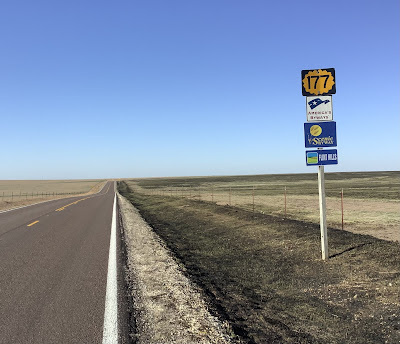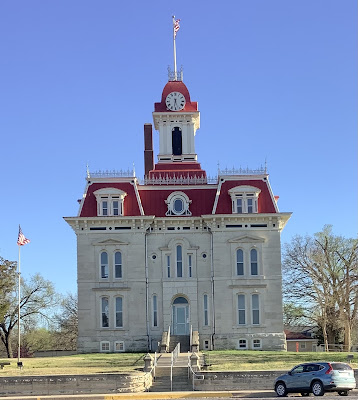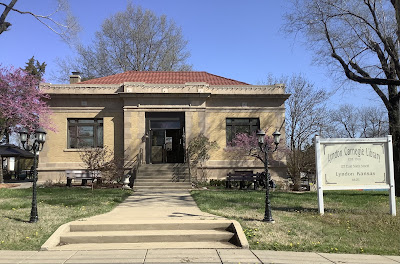A twenty mile per hour head wind from the south was taking some of the luster off riding through the storied Flint Hills, elevated to even more acclaim for hosting the premier gravel bicycle race in the world, but I had become accustomed these past days to pushing into such a wall of air, so accepted my lot, and occupied my thought as best as I could on the beauty of the tall grass prairie all about me as I pedaled along on one of the two National Scenic Highways in Kansas, this one twenty miles west of Emporia through Strong City and Cottonwood Falls.
I might not have ventured off on this byway if not for Laura, who grew up in the area and is another of my many friends I came to know through the Facets Cinemateque, including Janina. When Laura learned I was bicycling about her home state, she sent me a series of emails from Massachusetts, where she presently lives with her husband Ken, a fellow Facets volunteer, who teaches economics at Williams College. She apologized at one point for being so enthusiastic recommending the highway and other sites in the area, including the absolutely stunning courthouse in Cottonwood Falls.
I had to leave the highway for the courthouse, as it skirts the fringe of this small town. It is so spectacular there should have been signs along the road promoting it, but many a driver, as I would have too, passes by without realizing what a marvel is three blocks over. The towering edifice is almost a mirage at the end of the town’s Main Street, eliciting a spontaneous “wow” and “what in the hell is this doing here in a town of just 851 people. This isn’t France.” It goes back to 1873, when it’s population was no more than now, and is the oldest courthouse in the state still in use. It was designed by the same architect responsible for the state capital building in Topeka. It is comparable to city halls all over France that are the centerpiece of every French city.
Emporia offered up a similarly breathtakingly beautiful building, the domed Carnegie Library building of the College of Emporia with an address of 1200 C of E Drive, contrary to that of Wikipedia. It is of special significance, not only as the first of sixty-six grants he gave to the state in 1900, seven of which were to colleges, but because he gave it in remembrance of Col. John Anderson, the wealthy industrialist who opened up his extensive personal library to working boys in Pittsburgh on Saturdays. Carnegie, who ended his schooling at the age of thirteen to work in a factory as a bobbin’ boy earning $1.20 a week to help support his family, was so grateful to Anderson for the opportunity to read and learn that he vowed if he ever gained any wealth he would make a similar gesture himself, which resulted in the construction of 2,509 libraries all over the world.
The first library he funded in the US, after one in his hometown of Dunfermline in Scotland, was in Allegheny, Pennsylvania outside of Pittsburgh, where his family moved to from Scotland in 1848. He placed a bust of Anderson in front of it. Anderson happened to be the president of the board of trustees of the College of Emporia, founded in 1884, so Carnegie offered it a library and placed Anderson’s name on it. A plaque by the entrance expresses Carnegie’s connection to Anderson.
The College of Emporia closed in 1974 and was taken over by Way University. When it closed in 1991, it was given to Emporia State University, which never found a use for it as its campus was several miles away. It’s presently empty with a for sale sign out front.

Emporia received a grant from Carnegie for a library as well in 1902. It is presently a museum beside the new library. A couple blocks away the Gravel City bike shop, one of several in this cycling hotbed, had a small Gravel Hall of Fame which it inaugurated two years ago with an initial class of seven—Bobby Wintle, Chris Skogen, Corey Godfrey, Dan Hughes, Kristi Mohn, Mark Stevenson and Rebecca Rusch. Four more will be added this year in its second class before on May 31 during Unbound week—Alison Tetrick, Joel Dyke, Miguel Crawford and Yuri Hauswald. The shop offered a small booklet of recommended gravel rides in the area, ranging from several miles to over a hundred. I could have taken a gravel route the twenty miles to Strong City and the official scenic route through the Flint Hills, but with a twenty mile per hour wind to contend with I didn’t care to be blown all over the gravel road when I’d be trying to stick to bands with the least amount of gravel, so opted for the paved highway.
I had spent most of the previous day pushing into a strong headwind from Topeka for fifty miles to Burlington and it’s Carnegie, which is now in the private sector owned by Merry Investments.
My Garmin cyclometer beeps every five miles and gives me my time for those five miles. They were all over forty minutes, confirming my average speed was around seven miles per hour.
I had a rest stop at about the halfway point to Burlington at Lyndon’s quaint Carnegie tightly packed with tables and books. It’s prime alteration, besides the influx of computers, was the addition of a rest room on the first floor to go along with the usual rest room in the basement, where the children’s room invariably resides as well. I took advantage of the rest room to wash the first neckerchief of these travels, a purple one, a genuine prize. It was a long time in coming, twenty days and nearly fifteen hundred miles, but worth the wait. It will dangle off the back of my bike atop my tent and sleeping bag for the rest of these travels, a handy little swatch of fabric I can use as a napkin when eating for wiping my hands and knife and spoon.
After Burlington I headed west, turning the headwind into a side wind, dropping my five mile segments to under thirty minutes. My legs were so relieved they didn’t stop pedaling until the sun touched the horizon. It was a different story the next night in the Flint Hills when it was full on into a headwind greatly reducing my range. I was prepared to stop much earlier if anything presented itself, especially since the prairie terrain was relatively treeless and barbed wire fence lined the road. The rocky terrain wasn’t suitable for agriculture, though it’s stone made for good stacking as Janina and I saw Andy Goldsworthy construct at Kansas City’s Art Museum a few years ago.

The undulating terrain provided dips I could disappear into, but they would have been near the road, though there wasn’t much traffic. There wasn’t much tall grass in the prairie, as a million head of cattle graze on the two-county wide band of Flint Hills that extend from Oklahoma up through Kansas to just before the Nebraska border. There were patches of the grass here and there, some right along the highway.
As I scoured the terrain a church popped up in the distance. If there was no accompanying preachers quarters that would be a possibility. Just before it was a cemetery with a shed off to the side by a fence lined with trees. Cemeteries have proved me with accommodation before and once again.
The forecast called for the wind to blow all night, tapering to ten miles per hour, and not accelerating back to twenty until ten a.m. I set my alarm for six and dawn to take advantage of the diminished wind. I had twenty more miles south before turning west. With the surge of warm air from the south I was able to start the day in shorts for the first time. The wind slowly increased, but I reached the turn before the wind was a demoralizing force.
I feared the county road I turned on to would be gravel, but I was spared. After twelve miles I turned north for a few miles on a state highway. With a glorious wind at my back I registered a sub-twenty minute five-mile segment, one of the few of the trip, then turned west once again on a paved county road.
Among the many plaques in the area explaining the geology and the history and listing the twelve scenic roads in Kansas was one that mentioned Knute Rockne had died in a plane crash in the vicinity in 1931 at the age of 43 when he was at the pinnacle of the football world as the coach of Notre Dame. The road I was on didn’t go by the site, if any does, so I can’t report on whatever memorial there might be.
Another plaque with a map of Kansas showed the eleven physiographic zones of the state—besides the Flint Hills there was the high plains, red hills, Arkansas River lowlands, Wellington and MacPherson lowlands, Chautauqua hills, Cherokee lowlands, Ozark plateau, Osage cuestas, glaciated region, and the Smoky Hills. Kansas becomes more and more fascinating.















3 comments:
So glad you made it to and thru Cottonwood Falls! It was my grandparents and my father who actually grew up in the area, but I spent many a summer night there -- and a few in basements waiting out tornado warnings! -- but had also never seen the Courthouse, until I drove past it last summer on my way back from Oregon.
As always, I love your travelogue. Stay well. May the winds return to your tail! (not front on, slowing the mileage so!)
Laura
George, Laura did you right directing you to the Flints and through CF! That's some great cycling there. Always windy, though. Best times for getting through there are now (Spring) or Fall. Summertime gets pretty ferociously hot, and there's nothing in the way of shade except what you bring along or steal from a lone tree, bridge or building... and there's not many of those there. But what a beautiful part of our state, eh? 2b
Those "are" some of your best travel photos, George, distinctly different from the rest, offering such an overwhelmingly vast sense of emptiness and space, recalling the Clutter family farm in Holcomb, not that far away, the site of Truman Capote's In Cold Blood.
Post a Comment